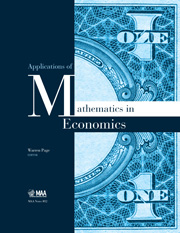Book contents
- Frontmatter
- Contents
- Preface
- Notes on the Sections
- Problems and Subject Areas
- 1 Microeconomics
- 2 Scenarios Involving Marginal Analysis
- 3 Intermediate Macroeconomics Theory
- 4 Closed Linear Systems
- 5 Mathematics in Behavioral Economics
- 6 Econometrics
- 7 The Portfolio Problem
- 8 Topics in Modern Finance
- 9 Maximizing Profit with Production Constraints
- About the Editor
- About the Authors
5 - Mathematics in Behavioral Economics
- Frontmatter
- Contents
- Preface
- Notes on the Sections
- Problems and Subject Areas
- 1 Microeconomics
- 2 Scenarios Involving Marginal Analysis
- 3 Intermediate Macroeconomics Theory
- 4 Closed Linear Systems
- 5 Mathematics in Behavioral Economics
- 6 Econometrics
- 7 The Portfolio Problem
- 8 Topics in Modern Finance
- 9 Maximizing Profit with Production Constraints
- About the Editor
- About the Authors
Summary
Introduction
Economists and psychologists who have explored the borderland between their two disciplines have created the field of behavioral economics. Economists have long understood that people don't always maximize their satisfaction or profits in the exact fashion that standard economic theory depicts. Behavioral economics has drawn economists' attention to numerous systematic deviations of human behavior that conflict with the predictions of standard economic theory. These systematic deviations can often be accounted for by psychological insights into human behavior. Social psychology and cognitive psychology have contributed particularly rich insights to behavioral economics.
This chapter introduces four topic areas in which behavioral economics relies on mathematics: (i) how attitudes about fairness can affect economic behavior; (ii) how people assess probabilities in practice; (iii) how people behave in the face of uncertainty; and (iv) how people make choices in an inter-temporal setting. Section 2 introduces a model of fairness that requires algebraic skills and the notion of a line's slope. Section 3 discusses systematic ways that people's probability assessments violate the mathematical rules of probability, and provides examples of their possible economic consequences. Section 4 contrasts the “prospect theory” posed by behavioral economists for understanding choices under uncertainty with “expected utility theory” often used in standard economics to understand choices under uncertainty. Drawing the insights from each relies on understanding basic features of concave and convex functions, and the concept of “expected value.”
- Type
- Chapter
- Information
- Applications of Mathematics in Economics , pp. 55 - 74Publisher: Mathematical Association of AmericaPrint publication year: 2013



